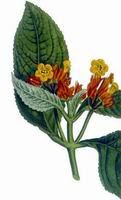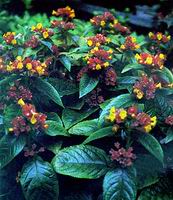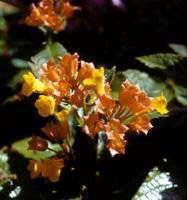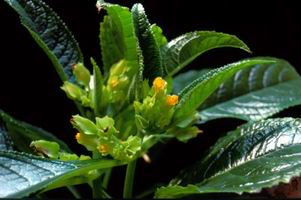
Bot. Mag., t. 1146 (1808)
Full name and orig. publication: Chrysothemis Decne., Rev. Hort. 21, s‚r. 3, 3: 242 (1849).
Etymology: Either derived from the Greek χρυσούς, chrysous = golden, gold-colored, and θεμις, themis = law, rule, or άνθη, anthē, άνθεμον, anthēmon = flower, alluding to the bright yellow or orange flower color, or (less probably) named after Chrysothemis of Greek mythology.
Synonyms: Tussacia Benth. (1846), Tussacia Raf. (1814), Tussacia Klotzsch ex Beer (1857), Tussacia Willd. ex Roem. & Schult. (1829).
Infrafamilial position: Gesnerioid Gesneriaceae (Gesnerioideae) - Episcieae.
Description: Terrestrial or epiphytic perennial herbs with tubers. Stems succulent, erect or rarely decumbent, subquadrangular. Leaves opposite, (sub)isophyllous, membranous. Petiole short, blade usually decurrent. Cymes axillary, sometimes appearing terminal by overtopping the stem apex, pedunculate, of 1-9 flowers, often umbellate, bracteolate. Sepals connate, calyx inflated or campanulate to urceolate, sometimes winged, yellow green, orange or red. Corolla tube cylindric, gibbous, internally with a ring of hairs at the stamen insertion, mouth oblique; limb flaring, lobes rounded, ± entire, yellow to orange with darker lines. Stamens 4, didynamous, included, staminode lacking; filaments slender, flattened, basally connate and inserted shortly above the corolla base; anthers orbicular, sometimes coherent, dehiscing by longitudinal slits. Nectary a bilobed dorsal gland, rarely of four separate glands. Ovary superior, globose, conical or ovoid, pilose; stigma bilobed. Fruit a fleshy, bivalved capsule, globose to ovoid, included in the persistent calyx.
Chromosome number: 2n = 18.
Species number: 7.
Species names (incl. publication and synonyms): See Skog, L.E. & J.K. Boggan. 2005: World checklist of Gesneriaceae: http://persoon.si.edu/Gesneriaceae/Checklist.
Type species: Chrysothemis pulchella (Donn ex Sims.) Decne.
Distribution: Ecuador to Guatemala, C Brazil, the Guianas, Venezuela and Lesser Antilles.
Ecology: In damp places and rocks in forests, usually at low elevations.
Notes: Pollination is probably by euglossine bees and/or hummingbirds, and seed dispersal possibly by ants which are attracted by the fleshy funiculi. C. pulchella and C. friedrichsthaliana (Hanst.) H.E.Moore are often grown as garden or greenhouse plants for their attractive persistent calyces and bright yellow flowers.
Selected references: Leeuwenb., Acta Bot. Neerl. 7: 329-340 (1958), rev.; Skog, Ann. Missouri Bot. Gard. 65: 825-830 (1979), reg. rev. (Panama); Feuillet & Steyermark, Fl. Venezuel. Guayana 5 (1999), reg. rev.; Skog, Monogr. Syst. Bot. Missouri Bot. Gard. 85: 1114-1128 (2001), reg. rev. (Nicaragua).
Bibliography: See Skog, L.E. & J.K. Boggan. 2005. Bibliography of the Gesneriaceae. 2nd edition: http://persoon.si.edu/Gesneriaceae/Bibliography.
Illustrations:

|
Chrysothemis pulchella
(Donn. ex Sims.) Decne., type species
Bot. Mag., t. 1146 (1808) |

|

|
Chrysothemis pulchella (Donn. ex
Sims.) Decne., type species
Left: Gloxinian 38/1, cover illustration
(1988) |

|
Chrysothemis friedrichsthaliana (Hanst.) H.E.Moore
Cult. BG Vienna, phot. A. Weber (1979) |
last modified: 2007-07-13